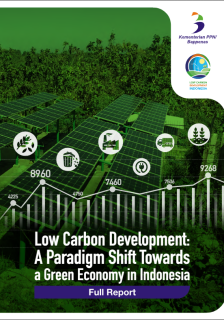In 2017, the Government of Indonesia declared its goal of integrating climate action into the country’s development agenda. The Low Carbon Development Initiative (LCDI) was launched at Indonesia’s Ministry of National Development Planning (BAPPENAS). The LCDI is a process for identifying development policies that maintain economic growth, alleviate poverty, and help meet sector-level development targets while simultaneously helping Indonesia to achieve its climate objectives and to preserve and improve the country’s natural resources. These low carbon development policies are expected to be internalised into the upcoming National Medium-term Development Plan (RPJMN) 2020–2024, which is part of the National Long-term Development Plan (RPJPN) 2005–2025. The implementation of LCDI policies will also contribute to achieving the Indonesia Vision 2045.
This report finds that a low carbon growth path can deliver an average GDP growth rate of 6 percent annually until 2045 as well as unlock an array of additional economic, social, and environmental benefits. Moreover, through the sustainable utilisation of its natural resources and by reducing its carbon and energy intensity, Indonesia’s total GHG emissions can fall by nearly 43 percent by 2030. This would surpass Indonesia’s conditional target in its Nationally Determined Contribution (NDC), presently set at 41 percent below baseline.
A summary for policymakers can be found here.
A brief can be found here.

